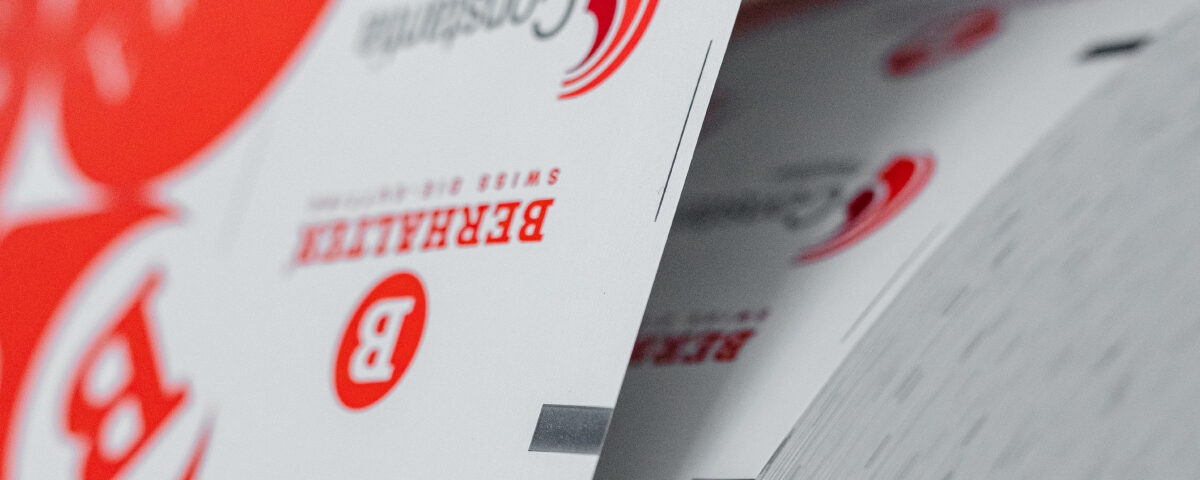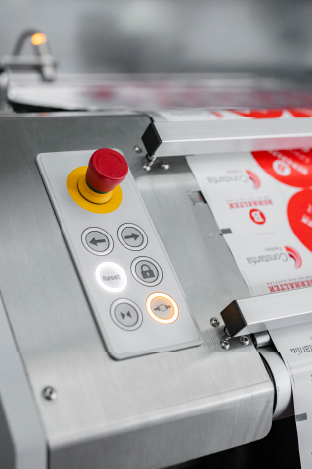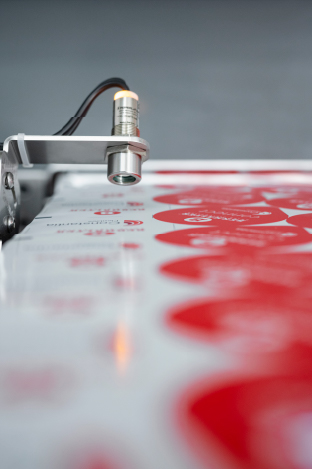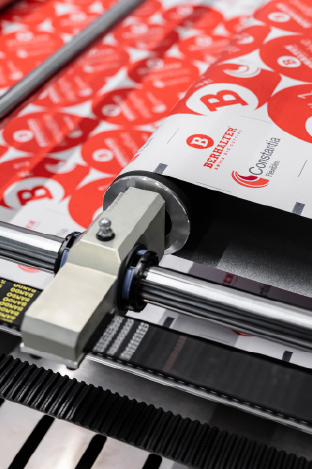Material Testing: The Strategic Foundation for High-Performance Die-Cutting ROI
Author: Tino Thür, BERHALTER Swiss Die-Cutting
Speed is the Goal. Precision is the Requirement. Material Testing is the Starting Point.
In today’s high-speed manufacturing landscape, businesses are under increasing pressure to improve output, reduce waste, and control cost without compromising quality. Investing in modern die-cutting equipment, capable of processing up to 500+ strokes per minute, has become essential to remain competitive.
Systems such as the Swiss Die-Cutter™ B6 and B4 demonstrate what is technologically possible: high throughput, digital integration, and flexible material handling. Both support substrates ranging from 25–200 µm, and even beyond depending on the application. But the true performance of any machine depends on how well the material behaves under real production conditions.
The limiting factor is often not the machine but the material.
Without understanding material behavior in advance, companies risk investing in equipment that cannot perform to expectations. That is why material testing is not just a technical precaution. It is a strategic requirement. It ensures that production parameters, machine capabilities, and material characteristics are aligned from day one.
"The limiting factor is often not the machine but the material."
Why Material Testing Drives Strategic ROI
Material testing reveals how materials respond to speed, pressure, and tension or mechanical load. This allows manufacturers to forecast output accurately, avoid inefficiencies, and maintain consistent product quality. All of these factors directly impact profitability.
Here is how:
1. Predictive Speed Optimization
High-speed performance depends on how reliably a material can be processed at maximum velocity. Materials that perform well at low speeds up to 300 strokes per minute may become unstable or deform when exposed to high mechanical stress from 300 to 500+ strokes per minute.
- Material testing identifies the threshold at which quality or stability begins to decline
- It clarifies what performance is realistically achievable with a given substrate
- The arrangement of the cavities in the punching tool has an immense impact on punching speed
- It is also important to test the stability of the grid under tension, which is directly affected by the alignment of the blanks (lids, labels, and so on)
Strategic Benefit: Enables accurate ROI planning based on tested throughput rather than unrealistic speed specifications.
2. Cost-Effective Waste Reduction
Minor inconsistencies in material quality, such as uneven thickness or surface variation, can lead to significant waste, especially at high cycle rates and speed.
- Testing highlights weaknesses that can result in jams, misfeeds, or failed cuts
- It enables adjustments to process parameters or investment decisions before production begins
- For example, if the foil tension is not optimized to match the material’s elastic behavior, even small feed variations can cause registration loss
- Thin substrates (e.g., 30 µm plastic film) are particularly prone to curling or tearing when subjected to high-speed mechanical loading, often resulting in web instability, jams, or increased scrap rates
Strategic Benefit: Reduces material loss and unplanned downtime by identifying risk factors early. Additionally, process variables like foil curling, tension shifts, or registration drift are often linked to material behavior under dynamic stress. Understanding how a material reacts, and how consistent those reactions are, makes it easier to maintain stable operation, particularly when working with light, flexible substrates.
3. Tooling Longevity and Reduced Downtime
Different materials affect tooling differently. For instance, substrates containing fillers or with abrasive surfaces can accelerate wear, increasing maintenance frequency.
- Material testing helps predict tooling lifespan under specific production conditions
- It also supports the selection of tool geometries or coatings aligned with expected stress profiles
- Highly filled or coated materials reduce the durability or usable life of the cutting tool
- Testing may reveal whether certain films require reduced clearance or different tool hardness to maintain cut quality over time
Strategic Benefit: Supports preventive maintenance planning and protects tool investment in the long term.
4. Quality Assurance and Customer Confidence
As production speeds increase, tolerance margins shrink. Material inconsistency, even if minor, can compromise cut quality and dimensional accuracy.
- Testing ensures that selected substrates meet quality expectations not only in controlled conditions, but also at production-scale speeds
- It provides a reference point for evaluating consistency between batches or across suppliers
- For example, thickness variation across a paper roll may lead to inconsistent embossing pressure or edge cracking
- Multilayer films with weak internal bonds may delaminate or distort under tension, resulting in quality deviations during high-speed cycles
Strategic Benefit: Helps maintain stable quality across shifts, orders, and material sources, contributing to brand reliability.

Why Material Testing Drives Strategic ROI.
Real-World ROI: Two Companies, Two Outcomes
To illustrate the difference material testing can make, consider two examples of companies preparing to scale up production.
Company A: Equipment First, Testing Later
This manufacturer invests in a high-speed system with the goal of increasing capacity by 40 percent. Their team assumes the existing material will remain compatible.
However:
- Production speed caps at 280 spm due to tearing
- Tool changes become frequent due to unexpected wear
- Misalignment and curling issues reduce yield
- ROI is delayed by several quarters
Company B: Testing Before Investment
This team begins with material analysis, followed by simulations and pilot testing
- Tensile strength, tear resistance, and consistent material thickness are evaluated across multiple suppliers
- Behavior is modeled digitally under expected stress conditions
- Short pilot runs confirm key assumptions in live conditions
As a result:
- Production reaches full speed within two weeks
- Scrap is reduced by 30 percent
- Tool wear matches predicted intervals
- ROI target is met ahead of schedule
Strategic Steps for Material-Driven ROI
To ensure your die-cutting investment performs as expected, integrate material analysis early in the decision-making process
✅ Data-Driven Material Selection
Key metrics such as tensile strength, tear resistance, and uniform thickness provide insights into a material’s suitability for high-speed converting
- Substrates outside standard ranges, for example below 25 µm or above 200 µm, may be viable but should be validated through controlled testing
Strategic Benefit: Increases certainty when evaluating alternative materials or new packaging formats.
✅ Simulation-Powered Investment Decisions
Sampling tools or qualification runs make it possible to evaluate how a material performs under high-speed conditions before transitioning to full-scale production.
- Key variables such as deformation, web tension, and cutting force can be analyzed using specialized lab tools
- Platforms like CUTcontrol™, available with the B4 and B6 systems, support real-time process monitoring, predictive analytics, and tooling validation — providing a reliable data foundation for ROI forecasting
Strategic Benefit: Minimizes commissioning risk and ensures production targets are based on validated performance data.
✅ Validation Through Pilot Testing
Even with strong data, pilot runs remain essential to confirm assumptions
- Small-scale testing identifies how materials behave in live settings
- It also helps fine-tune feed tension, speed, and die clearance to match real-world variation
Strategic Benefit: Minimizes ramp-up time and ensures faster time-to-value after installation.
✅ Process Stability and Repeatability
Material behavior can vary not only between suppliers, but even within the same batch over time. Testing helps identify how different substrates perform under consistent process conditions and provides a benchmark for long-term repeatability.
- Material testing enables fine-tuning of parameters such as feed speed, tension, and stroke profile
- It also helps establish quality baselines for ongoing production monitoring
Strategic Benefit: Improves process control and supports long-term production reliability across shifts and production volumes.
Conclusion: Invest in Insight to Choose the Right Equipment
The capabilities of modern die-cutting systems such as the Swiss Die-Cutter™ B6 and B4 are impressive. High speed, servo control, and flexible tooling enable production of lids, labels, and specialty formats at an industrial scale.
The right technology can help you achieve a strong return on investment (ROI).
True success comes from aligning the right equipment with the right material, and that alignment begins with strategic testing.
Material testing provides the evidence needed to plan accurately, reduce surprises, and scale with confidence. It transforms decision-making from reactive to proactive and turns unknowns into measurable inputs.
👉 Are you planning your next die-cutting investment?
Start by understanding your material and ensure your equipment can deliver the results you expect.








